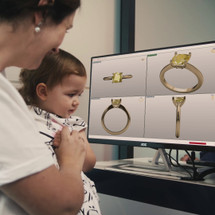Aug 23, 2023
3D Design, Scanning and Printing for Jewellery
Computer Aided Design has a fascinating history which dates back to Dr Patrick J Hanratty’s development of the first commercial numerical-controlled programming system Pronto in 1957, which was shortly followed by the first 2D drafting software Sketchpad, developed by MIT’s Ivan Sutherland in 1960. Computer 3D modelling first appeared in 1969, however it wasn’t until 1983 that Charles Hull produced the first printed component from a computer’s 3D model using his patented SLA technology. Military and Aerospace investment soon followed and so the scene was set.
The jewellery industry has benefitted from the advancements of 3D modelling, printing and scanning which has been seen in the industrial, medical and cinematic effects industries. Jewellers have been quick to take up this emerging technology in an effort to improve their productivity and reduce overheads while proving their customers with a unique creation.
For the over 20 years, the jewellery industry has been at the forefront of developments in 3D design and rapid prototyping and as the technology has improved in accuracy and detail, the relevance in jewellery design has reached the stage where many processes previously done by hand have been replaced by CAD, including both one of a kind bespoke items and manufacturing masters models for production.
3D modelling software essentially falls into one of two categories; software that builds by using a series of curves and points as set by the designer, which allows for precise hard edges; and those that use virtual ‘clay’, allowing the designer to model truly free-form and organic shapes with fantastic levels of detail. Given the dramatically different approaches and outcomes it is not uncommon for designers to utilise more than one software package to ensure the best of both worlds.
Similarly, 3D scanning has more than one approach, however when it comes to capturing the fine detail commonly associate with jewellery, there is a somewhat more limited choice. Echo utilises the structured blue light technology of the Rexcan DS3 scanner. Blue light has a shorter wavelength allowing for greater detail and the Rexcan DS3 uses a complex series of movements and patterns projected across the item which is in turn captured by a dual-camera system, allowing the scanner to interpret the play of light across the item’s surface and triangulate where that light is in space to plot a point cloud within a virtual space. Of course working with light means that transparent or shiny surface will interfere with the scan, so a temporary matte finish is required. The computer can then convert the point cloud into a solid object ready for 3D modelling or printing.
Computer Aided Manufacture (CAM) is the means by which a 3D model is brought into the real world and can broadly be categorised as additive, such as printing; or subtractive, such as milling. Within the jewellery industry the choice of CAM method is dependent on the design and function of the item. We have the option to 3D print and item using hot wax extrusion, constructing the item using successive layers of wax built one upon the other, or growing the item from a pool of resin utilising an ultraviolet laser to harden the material with pinpoint accuracy.
Alternatively, we can machine a block of wax, brass or aluminium into the desired shape using a computer controlled milling machines, which are fantastic for high precision models with no internal details. All these methods can be used in combination with the traditional moulding and lost wax casting techniques to cast the final item in gold or other precious metals. The most recent development in CAM technology however, utilises a micro laser welder to fuse powdered metal layer by layer, building the model directly into the desired alloy, further reducing the cost associated with bespoke jewellery.
Amongst all this progress, more and more jewellers are utilising CAD/CAM technologies to maintain their competitive edge in both price and design, while pushing the boundaries of design and what is possible. CAD/CAM certainly has not replaced the traditional skills of the jewellery trade, but it has changed the way that customers and jewellers create bespoke jewellery and the way that we as consumers document and connect with our most precious personal items.

